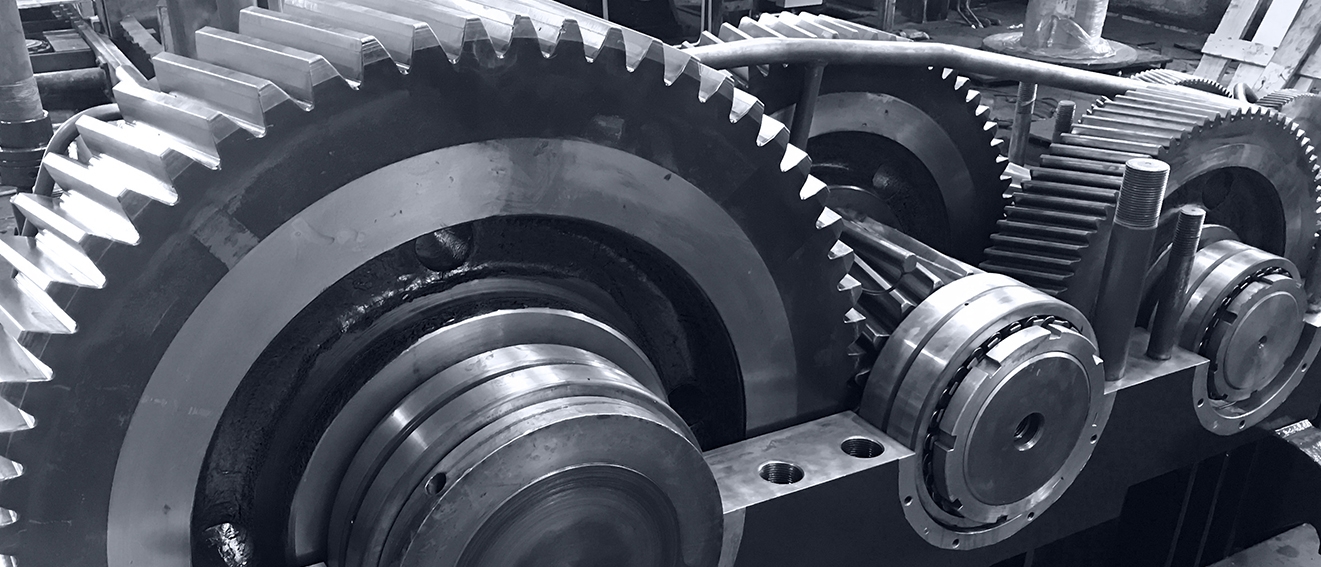

Global Mining Review: Gearing Up - The importance of open gear lubricants and how to optimise their performance.
Posted on 08/04/21 in: Technical Knowledge | Published Articles | | Petrochemical | Refinery | Utilities / Power Generation | Valve Maintenance | Oil & Gas | Mining | General Industry | Plant Maintenance | Author: Don Howard, Bob Yerkes
Open gear lubricants are an essential component of virtually all mineral and metal mining and processing operations. They are used in major mobile equipment, such as walking draglines and electric rope shovels, where they are a critical power transmission component for drag, hoist, crowd, and propel systems. They are just as important on the processing side of mining, where they are used on large open gear driven rotating machinery such as tube mills, kilns, dryers, and other similar machinery.
There are differences between the mobile and process open gear applications, as well as the lubricants used on them. Mobile equipment open gears are usually bidirectional and operate with continuous, cyclic speed variations. Process open gears operate in one direction and at a constant speed. This article focuses on process open gears.
There are four primary types of process open gear lubricants according to AGMA and ISO standards. These are greases, residual and compound lubricants, and oils. The types of open gear lubricants are defined according to the pertinent standards in Table 1.
Residual open gear lubricants
The AGMA 6014-B15 defines residual open gear lubricants as including high viscosity mineral or synthetic fluids with a diluent to facilitate pumping and spraying. To allow for diluent evaporation and film formation, many gear original equipment manufacturers (OEM) recommend application intervals of 15 – 20 minutes. In some cases, the intervals may be extended further depending on the performance characteristics of the specific lubricant. Once diluent evaporation occurs, at least in part, a residual open gear lubricant operates in the full fluid film or hydrodynamic mode. These lubricants are additised, including the use of anti-scuff additives and often lubricating solids, such as molybdenum disulfide or graphite.
The AGMA standard description of residual open gear lubricants implies the potential use of asphalt as a base fluid. However, many lubricant suppliers have removed asphalt from their formulations in favour of viscous paraffinic resins and polymers for both performance and regulatory reasons. The ISO standard continues to refer to residual open gear lubricants, such as asphaltic or bituminous.
Whitmore Envirolube® XE Extreme Open Gear Lubricant is a high performance AGMA residual open gear lubricant. It utilises petroleum resin-polymer base fluid and proprietary MicroslideTM technology to provide anti-scuff protection and to smooth rough tooth surfaces, improving the tooth contact pattern and thus reducing wear, friction, and operating temperature.
Compound open gear lubricants
As stated earlier, AGMA B6014-B15 does not recognise compound open gear lubricants, apparently combining them into their definition of residual open gear lubricant. According to the ISO 18792:2008, a compound open gear lubricant is a mineral or synthetic base fluid, possibly viscosity modified. A compound open gear lubricant contains anti-scuff additives. Solid lubricants such as molybdenum disulfide and graphite may be used. A diluent may also be used to promote pumping and spraying. If a diluent is used, like residual open gear lubricants, spray intervals are typically extended to 15 – 20 minutes to allow for diluent evaporation. Once diluent evaporation occurs, at least in part, a residual open gear lubricant operates in the full fluid film or hydrodynamic mode.
Whitmore Envirolube XE Extreme with its Microslide technology meets the definition of an ISO 18792-2008 compound open gear lubricant.
Residual and compound open gear lubricants have been used for many years. The company’s Envirolube XE Extreme, a high viscosity, non-asphaltic residual or compound lubricant, represents an advancement in the technology of these types of open gear lubricants with key features being high load carrying potential, draining of spent lubricant to waste for easy disposal, and gear tooth surface smoothing through the Microslide technology.
Grease open gear lubricants
Open gear greases are based on mineral or synthetic fluids thickened with a metallic soap. Aluminium complex soap are the most commonly soap used. Other thickeners can be used with simple and complex lithium soaps and calcium sulfonate complex thickeners being likely candidates. Anti-scuff additives are essential to open gear greases because they form thin lubricating films and operate in the boundary mode during which, depending on tooth surface roughness, metal-to-metal contact may occur. Lubricating solids such as molybdenum disulfide and graphite are often used. More recent open gear grease developments are light coloured, some near white.
Open gear greases tend to operate in the boundary mode making anti-scuff (extreme pressure [EP]) additives essential to the safe operation of girth gear drives. ASTM D2596 Four Ball EP Test Weld Points of 500 – 800 kg are common.
To further reduce the likelihood of surface contact and to improve wear control, many open gear grease suppliers offer running in compounds. These are specialised open gear greases with additives to modify tooth surfaces, reducing asperity height and the likelihood of surface contact. Increasing the contact area reduces contact pressure, potentially reducing temperature, wear and friction, increasing gear life. Conceptually, these are similar to the company’s Microslide technology used in the Envirolube XE Extreme. The primary difference is that the technology is included in the Envirolube XE Extreme operational product as a standard component. Microslide is temperature activated, responding locally to the heat generated by asperity contact, treating surface changes as they begin to occur and on an ongoing basis. Most open gear grease suppliers use a separate running in compound which is periodically utilised for 300 – 500 hours to smooth surfaces after surface changes have already occurred.
Mobile equipment, such as walking draglines and electric rope shovels, present a more complex lubrication model than process equipment. Open gear greases formulated for mobile equipment often have higher base fluid viscosities than those formulated for process equipment. However, open gear lubricants designed for mobile equipment are also suitable for use on process equipment. In general, the converse is not true. Open gear greases formulated for process equipment often do not perform well on mobile equipment. A primary advantage that higher base oil viscosity open gear greases may have is their tendency to form thicker lubricating films providing improved surface separation.
An issue with some open gear greases is their lack of mobility. Many do not drain to waste and periodic cleanout of the housing is necessary. Whitmore GearMate® 1000 ICT Open Gear Lubricant, a lithium soap thickened open gear grease, performs well on process equipment despite having been designed for use on walking dragline and electric rope shovel open gears. Its heavy base oil viscosity tends to form a thicker lubricating film than most open gear greases. On the downside, drainage is slow.
Alternatively, SurStik® 800 Open Gear Lubricant is an aluminium complex thickened open gear grease which performs much like its European competitors, despite having been formulated for walking draglines and shovels. The company’s SurStik 800 NLGI 00 is an aluminium complex open gear grease that is suitable for process open gears.
Open gear oils
Open gear oils are mineral or synthetic fluids, generally containing anti-scuff additives. Friction modifiers are often used. Diluents are generally not necessary. Open gear oils are a relatively recent addition to the list of lubricants having been introduced approximately 20 years ago, especially considering that open gear greases may have been introduced nearly 70 years ago. They have gained in popularity and are now widely used.
Most of the open gear oils applied by intermittent spray are synthetic or synthetic blend fluids. Common viscosities range from 8000 to 30 000 centistokes (cSt) at 40˚C. Some of the most widely used open gear oils fall into a viscosity range of approximately 15 000 to 18 000 cSt at 40˚C. Because of their high viscosities these products promote surface separation, i.e. they operate in the full fluid film or hydrodynamic lubrication mode. The Whitmore Decathlon® Gold Super Heavy Open Gear Lubricant is an example of a high viscosity open gear oil, that also contains the Microslide technology.
An advantage that open gear oils have is their ability to safely clean gears during normal full scale production. Open gear oils will dissolve the heaviest films and accumulations of previously used open gear lubricants. Even heavy root accumulations will be progressively removed. Generally, gear cleaning begins immediately and is completed in approximately 10 days under normal production. The cover will also be eventually cleaned.
|
Table 1. Open gear lubricant classification and definitions |
||
|
Type of lubricant |
AGMA 6114-B15 |
ISO 18792:2008 |
|
Residual |
Residual compounds are a viscous mixture of petroleum or synthetic compounds with a diluent. Most residual compounds use non-chlorinated diluents to provide pumpability. Most contain anti-scuff additives and friction modifiers such as graphite and molybdenum disulfide. Residual compounds operate on the principle of an oil film separating gear and pinion teeth. |
Residual compounds are a viscous mixture of petroleum-based compounds, also referred to as asphaltic or bituminous. Most residual compounds use non-chlorinated diluents to provide pumpability. The use of residuals is often restricted for ecological or health reasons. |
|
Oils |
Petroleum or synthetic oils that may contain anti-scuff additives and friction modifiers. Solvents are generally not used. Oils operate on the principle of an oil film separating gear and pinion teeth. |
Oils are either mineral-based or synthetic with EP (anti-scuff) additives. |
|
Greases |
Greases are petroleum or synthetic oils to which soap thickeners are added. Friction modifiers such as graphite or molybdenum disulfide and anti-scuff additives are usually added. Greases are usually not as adhesive as other lubricants. Additives (anti-scuff) in the grease allow it to operate in or near the boundary mode. |
Greases are petroleum or synthetic oils to which soap thickeners are added. Solid lubricants such as graphite or molybdenum disulfide and EP (anti-scuff) additives are usually added. Additives in the grease allow it to operate in or near the boundary mode. Greases should be adhesive. |
|
Compounds |
Compounds are no longer a separate classification. They are included in the residual compound description. |
Compounds are either mineral or synthetic based with or without solid lubricants and EP additive. Some contain diluents for better pumpability. Some contain polymers as viscosity enhancers. |
Conclusion
AGMA 6014-B15 and ISO 18792:2008 describe open gear lubricant types and, although the standards are quite different regarding viscosity, they provide minimum viscosity or base oil viscosity recommendations for them. These are only minimum recommendations which may not address critical operating environments, such as ambient temperature and contamination.
The different lubricant types generally perform adequately when used correctly. Often, the optimised lubrication of open gears is a commonsense blend of lubricant quality and design, lubricant supplier application expertise, monitoring resources and competence, OEM requirements, and industrial standards and guidelines.
To read the PDF article, click here:
